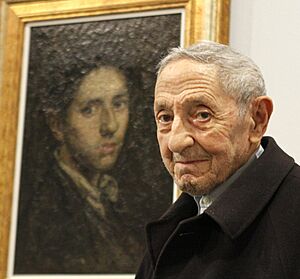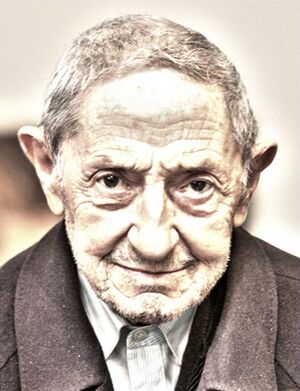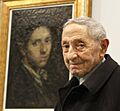Isaac Díaz Pardo facts for kids
Quick facts for kids
Isaac Díaz Pardo
|
|
|---|---|

Díaz Pardo
|
|
| Born | August 22, 1920 Ferrol, Galicia, Spain
|
| Died | January 5, 2012 (aged 91) Cerceda, Galicia, Spain
|
| Nationality | Spanish |
Isaac Díaz Pardo (born August 22, 1920, died January 5, 2012) was a very smart person from Galicia, Spain. He was closely connected to two important companies: Sargadelos and Cerámica do Castro. He was known for his many talents and his love for Galician culture.
Contents
Isaac Díaz Pardo: A Creative Life
Isaac Díaz Pardo was a painter, a ceramist (someone who makes things from clay), a designer, an editor, and a businessman. He was born in Santiago de Compostela and passed away in A Coruña.
In 2009, he received a special award called the Gold Medal of Merit in Fine Arts from Spain. This award recognized his amazing contributions to art and culture.
Early Life and Family
Isaac Díaz Pardo was the son of Camilo Díaz Baliño, who was also a painter and a designer for theater sets. Their home was a meeting place for people who loved the Galician language and culture. Important artists and thinkers like Castelao and Vicente Risco often visited.
Isaac is seen as part of a group of artists from the 20th century who helped bring new ideas to Galician art. They were known as Os renovadores, which means "the renovators."
Education and Artistic Journey
During a difficult time in Spain, Isaac's father faced danger. Isaac had to hide in La Coruña, where he worked as a sign painter. After this period, he received a scholarship. This helped him study at the Royal Academy of Fine Arts in Madrid from 1939 to 1942.
Later, he taught art in Barcelona. He started showing his artwork in Spain and in other countries in Europe and the Americas.
From Painting to Ceramics
Isaac then became very interested in ceramics. He started a factory called Cerámicas do Castro with some friends. He experimented with materials used in old 19th-century pottery from places like Sargadelos and Cervo. This helped him create very high-quality ceramic pieces.
Building Cultural Projects
In 1963, Isaac Díaz Pardo, along with other important Galician thinkers like Luis Seoane, helped create "Porcelanas de Magdalena." This was an experimental factory in Argentina. It was a first step for many other cultural and industrial projects.
These projects included bringing back pottery making at Sargadelos, with help from Cerámicas do Castro. They also started the Museo Carlos Maside (a museum), Ediciós do Castro (a publishing house), and helped restart the Seminario de Estudos Galegos (a study group). Isaac was a key person in the Sargadelos Group for a long time.
Writing and Ideas
Isaac Díaz Pardo was also a talented writer and critic. He wrote many essays and articles for newspapers like La Voz de Galicia. His writings shared his thoughts on art, culture, and Galician identity.
Images for kids
See also
 In Spanish: Isaac Díaz Pardo para niños
In Spanish: Isaac Díaz Pardo para niños






